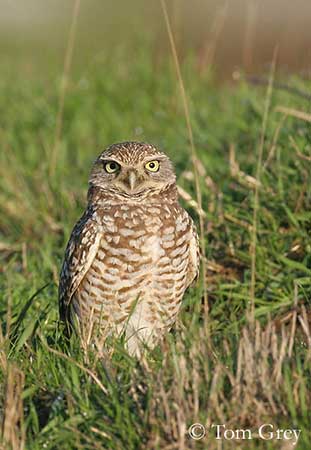
Burrowing Owl
Athene cunicularia
Strigiforme Order – Strigidae Family
BIOMETRICS:
Length: 19-25 cm ; Wingspan: 55 cm ; Weight: 170-214 g
LONGEVITY: up to 8 years
DESCRIPTION:
Burrowing Owl has rounded spotted head, but no ear tufts. Plumage is pale brown spotted with white on the head, back and upperparts of the wings. Underparts such as breast and belly are whitish with brown barring. It has white chin stripe.
On the face, Burrowing Owl has white eyebrows and yellow eyes. Tail is short. Legs are relatively longs.
Bill is yellow and white or yellow and black.
Female is darker and more streaked below than male.
Juvenile has plain brown head, upper breast has dark tan band, and lower breast and belly are whitish.
Several subspecies share the distribution. They differ in size, and in intensity of plumage coloration and markings.
VOICE: SOUNDS BY XENO-CANTO
Burrowing Owl male utters a two notes call “coo-cooo”, with the second note longer than the first. This call is used in pair formation and territorial display.
If an intruder approaches the nest-burrow, the “guard” outside gives a six-note alarm call “chip-chip-chi chi chip-chip”. When there is closer approach, Burrowing Owl bobs up and down, and utters a higher-pitched harsher “cheed”.
When the youngs are threatened, they give a rattlesnake rasp, because emanating from the burrow, this call resembles the rattle of this snake.

HABITAT:
Burrowing Owl lives in open dry grasslands, in cultivated areas, range lands and desert habitat. It lives in burrows. This species can be seen from sea-level up to 4500 metres of elevation.
RANGE:
Burrowing Owl is found in western North America, from southern Canada to Mexico. We can also find it in Florida, in West Indies, but also in Central and South America.
BEHAVIOUR:
Burrowing Owl spends most of its time on the ground, and it may live in loose colonies. To search for prey, it may hover above the ground. It is a diurnal bird, but however, most of its hunting may be crepuscular, at dusk and dawn, or nocturnal.
Burrowing Owl employs a number of techniques to capture prey. In the early evening, it locates the prey by flying about and hovering, while looking at the ground below. But it may hunt and locate prey from an elevated perch. Then, it descends to the ground and walks, hops or runs after the prey. And sometimes, it plucks flying insects, which it catches with feet.
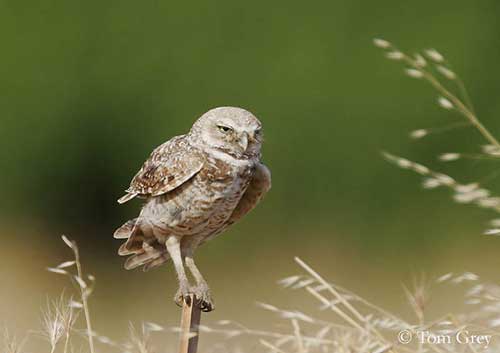
Burrowing Owl swallows the prey whole or in large bits, and it regurgitates pellets which contains feathers, fur, bones and teeth.
Burrowing Owls adults and juveniles spend little time outside their burrows during midday hours in summer, at the end of breeding season. These owls remain underground during hard winters.
Burrowing Owl enlarges or renovates existing burrows of burrowing mammals. This place may be used year after year. They may dig, remaining on one leg while they kick dirt backwards with the other leg.
Burrowing Owls collect horse and cow manure to line the floor of the burrow. Studies suggest that the odour of the dung may mask that of owls, and protect them from detection by ground predators.
Burrowing owls are migratory in the northern part of their range. But as they spend most of their time in burrows during winter, some observers explain their apparent disappearance by this fact.
Courtship display includes calls, bowing, scratching, and the male performs flight displays, rising quickly, hovering for a few seconds, and dropping from 50 feet. It repeats this scene many times. It also performs circling flights.
FLIGHT:
Burrowing Owls have an agile flight, performing beautiful flight displays, and hovering while searching for food.
REPRODUCTION:
Breeding season occurs from March to August.
Burrowing Owls are monogamous, but sometimes, a male may have two mates. It nests in abandoned burrows dug by mammals, but occasionally, if soil conditions are good, it will dig its own burrow. It lines its burrow with dry materials. They have several burrows around the most important. They are used by males during nesting period and by juveniles after they go out from the first nest.
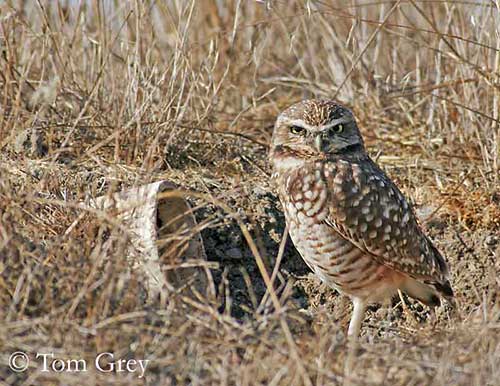
Female lays 6 to 9 white eggs, laid a day apart. Incubation lasts about 28 to 30 days by female alone. Male feeds her during the incubation and surveys the burrow during the day.
Male performs the care of young while in the nest. Two weeks later, young roost at the entrance of the burrow, waiting for food brought by adults.
They fledge at about 44 days of age, and begin chasing insects when they are 50 to 56 days old.
This species produces only one brood per season.
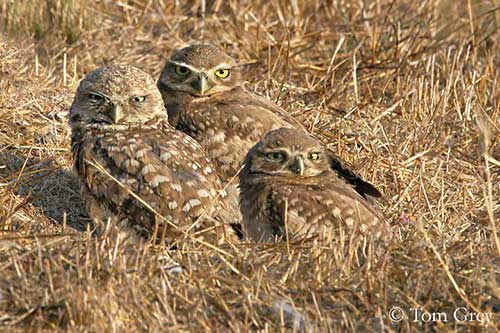
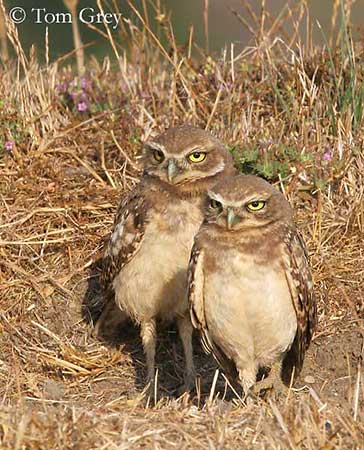
DIET:
Burrowing Owls feed on large variety of prey, according to the food resources of the place.
It feeds mainly on beetles and grasshoppers, but also small mammals (mice, rats, ground squirrels). It may feed on reptiles and amphibians, scorpions, bats and birds. They also consume fruits and seeds.
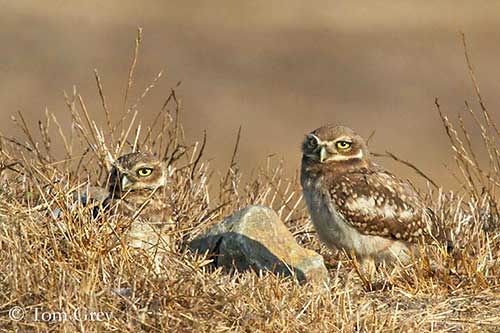
PROTECTION/THREATS/ STATUS:
Burrowing Owls are often killed by collision with vehicles, but they also have predators, such as larger Owls, Hawks, Falcons, Skunks, Snakes, Cats and Dogs.
Populations of Burrowing Owls are declining by habitat loss and use of pesticides.
Fr: Chevêche des terriers
All : Kaninchenkauz
Esp : Mochuelo de Madriguera
Ital: Civetta delle tane
Nd: Holenuil
Russe: Сыч кроличий
Sd: Prärieuggla
Photographs by Tom Grey
His website :
Tom Grey's Bird Pictures
Text by Nicole Bouglouan
Sources:
HANDBOOK OF THE BIRDS OF THE WORLD Vol 5 by Josep del Hoyo-Andrew Elliott-Jordi Sargatal - Lynx Edicions - ISBN: 8487334253
Animal Diversity Web (University of Michigan Museum of Zoology)
Wikipedia (Wikipedia, The Free Encyclopedia)
What Bird-The ultimate Bird Guide (Mitchell Waite)
All About Birds (Cornell Lab of Ornithology)